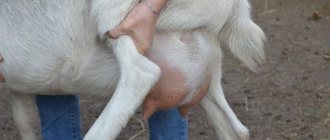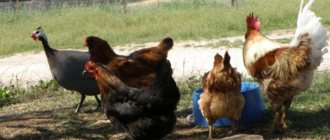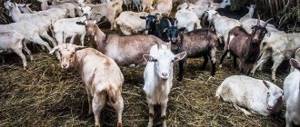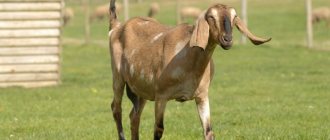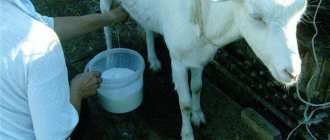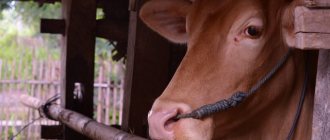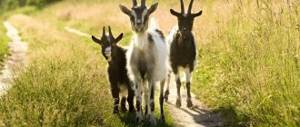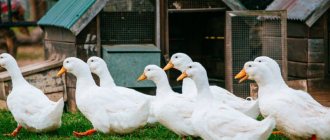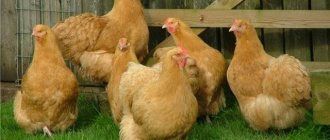Goat wintering shed
The main condition is a dry barn without any drafts. Heating in the barn will only be needed when raising newborn goats. Adult goats independently regulate their body temperature, so they can easily withstand frost in unheated rooms.
In winter, they are kept in stalls, and it is important for the owner to take care of the living conditions and stock up on adequate food.
Even when building a goat house, it is necessary to take into account several points:
- locate it away from garbage dumps and manure pits;
- the presence of windows is mandatory; natural light must enter the barn in large quantities;
- The room must be dry, animals cannot tolerate humidity. And if there are also drafts, they easily get pneumonia - pneumonia.
That is why wood is used for construction; it retains heat better when concrete or brick retains more moisture and dampness.
Winter conditions
The optimal temperature in the barn is +7°C when keeping adults and +10°C when there is a goat with kids in the stall. At lower temperatures, goats need to be insulated with clothing. To do this, they put on old jackets and coats over their front legs and button them at the back. The emphasis is on protecting the animal's chest to prevent the development of colds.
Each animal needs a separate compartment. Goats are freedom-loving animals, so they need to be given a spacious place. Depending on the individual, different stall areas are required per animal:
- kid from 6 months to 1 year - 1.2 sq. m;
- barn goat and breeding male - 2 sq. m;
- female with cubs - 3.5 square meters. m.
There are two types of feeders. Rough feed (hay and straw) is placed in the nursery, concentrates and vegetables are placed in special individual feeders. Install them at a height of 40-50 cm from the floor.
Preparing the barn for winter
To ensure that the wintering of goats goes without problems, goat's rue is prepared, guided by the following recommendations:
- It is better if the goat house has several small windows on the south side than one large one. They are made at a height of more than 1.5 m, otherwise jumping pets may inadvertently knock them out with their hooves. For the winter they are insulated, all cracks are sealed.
- Ventilation is also an important part of the shed; it is through it that air circulates and excess moisture escapes. It is especially relevant during the cold period, since manure in stalls is removed less frequently to save heat. The best option is to equip the room with two ventilation systems. One is located in the form of a tetrahedral pipe under the roof of the goat house, through which stale air is removed. A second pipe or several holes are made below the floor at the beginning of the walls, thanks to which fresh and clean air constantly enters the room and circulates it.
- To save heat, dampers are installed in winter. Some farmers install special filters that heat the incoming air.
- The walls are whitewashed with lime mortar, the whitewashing is renewed 2 times a year. They are insulated using the old-fashioned method - sawdust or wood, or a more modern method is used - an additional artificial wall is placed.
- Along the insulated walls, beds for animals (sleeping places) are attached - 70-80 cm long and 50-60 cm wide. With their help, several problems are solved: goats have a luxurious place to rest, wool gets less dirty in manure and bedding, and the risk of catching a cold is reduced. . The sunbeds also need to be whitewashed.
- It is recommended to use a plank floor; it is easier to clean from manure. However, this does not mean that concrete, clay or dirt floors do not have their place. The floor is raised by 20-25 cm and made at a slope (2 cm per 1 m of room) so that the liquid drains immediately. To remove it from the shed, it is recommended to dig grooves through which the waste will immediately go into cesspools.
- The floor is covered with a thick layer of bedding made from natural materials - peat, sawdust, hay, dry leaves, straw, moss. If the barn does not have beds, then the animals have to sleep on the floor, so you need to approach the floor covering responsibly.
- A well-lit canopy is made in front of the entrance to the goat house. They do not allow the room to cool down.
and feeding goats at home
goats are profitable.
These animals produce healthy, tasty milk that you can drink yourself or sell. They also produce wool, meat and kids. But is it difficult to keep these animals? It all depends on the breeder and the breed - not everyone is able to care for animals, and exotic breeds are more capricious than simple, local ones.
The article will describe how to keep goats at home for novice breeders, what they need for normal life.
What should a goat's rue be like?
You can keep goats in a goat shed, a barn, or even an attic; they can easily get in there, but in any case, the room needs to be equipped for the animals, since they need a place to sleep, eat, give birth, and so on.
The size of the room directly depends on the number of goats. But in any case, it should be spacious so that it is convenient to move around it, take the animals for walks, milk them, and inspect them. If there are more than 5 goats, it is worth taking care of separate stalls for them, because individuals often fight, and this can protect them from possible problems.
You can keep goats in a goat shed, a barn, or even an attic.
There are 1-2 animals in each stall. The exception is a female with cubs. If the kids are not taken away, there may be 3-4 or even more animals in the stall - a female and all her offspring. This is how the goat and kids will be kept until the latter learn to live independently and eat simple food, and not mother’s milk.
It is important to note that males are always kept separate from females, as the milk may carry a strong odor from the goat.
The recommended stall dimensions for one individual are 1x2 meters. Of course, if the goats are large breeds or dwarf, then the sizes are adjusted. These are suitable for the simplest ones, like Russian White. A separate stall is built for the female and her cub - spacious, approximately 2-2.5 meters square.
It is important to note that the kids, after they grow up and are separated from their mother, need to be placed in one common stall measuring 2-2.5 m/sq. There they must live until they become completely independent and adults. This is done to save space and to allow the animals to socialize.
Now about the technical side of the goat's rue.
- Cold, lack or abundance of sunlight are not terrible for goats, but drafts can greatly harm their health. If a goat is always in a draft, it begins to have problems with its legs, hooves, ears, and eyes. The problem is difficult to notice right away, and over time it may be too late to treat it, so when arranging a goat's rue it is worth making it as protected from drafts as possible.
- Dampness also has a bad effect on goats, bucks and kids. It occurs if the room is not ventilated or is ventilated, but poorly. Due to the fact that air stagnates, condensation occurs, which leads to high humidity. Humidity provokes respiratory diseases and lung problems in these animals. But it’s easy to solve the problem by making the most basic and primitive, but adjustable, ventilation system in the room.
- Temperature is also very important. In the southern regions, low temperatures are rare, so goats are often kept there even on the street, but in more northern cities you need to worry about insulating the walls and floor of the goat shed. In winter, the temperature inside should not fall below +6 degrees Celsius, and if the breeder also has kids, then not below +8 degrees.
- The windows are placed at a height of 1.5 meters so that animals do not break them in a fit of play.
How to set up a goat house?
After building the main premises, you need to think about how to arrange the goat shed so that keeping goats is simple and not troublesome.
Goats love to sleep on high places
- It is advisable to make feeders in a common room, and not in each individual stall. They are usually long troughs. They are hung at such a level that it is convenient for the animals to eat, but it is not recommended to place them on the floor so that the animals do not walk on the troughs and contaminate the food. The length and height of installation of troughs depends on the number and age of animals.
- Water bowls are another matter; they can be placed in every stall, especially since there should be water in the stall with a pregnant or lactating female. Sometimes water is simply poured into buckets, but kids can turn them over, so it’s easier to make special mechanical drinkers or pour water into hanging buckets.
- Goats love to sleep on high places. If you put bales of straw in the goat's coop, they will certainly climb on them and sleep there. To make things easier for them, it is worth placing a small bale in each stall so that they can sleep comfortably. Such fraud will also protect them from illness - sleeping on soft straw is much more pleasant than on a cold floor, even with a bedding.
- To keep the air in the goat's coop clean and free from unpleasant odors, the floor is made on a slope and a drain is installed below so that all the liquid pours out there. This will significantly improve the appearance and condition of the goat house, and keeping goats will become a much more enjoyable process.
- It is worth worrying about the bedding. Usually it is placed only in stalls, since it is not required in the common room - goats do not sleep there. It is made from coarse, cheap straw that animals will not eat.
How and what to feed goats?
Goats at home in summer and winter are very different. First of all, this concerns feeding. On warm days, goats eat mainly greens - grasses that they can find while grazing. In winter, there is no walking area and no greenery, so the animals are switched to roughage.
In the summer, in addition to greens on the range, you need to give goats feed or bran with vitamin and mineral supplements, hay, and root vegetables. Whole grain is never given to goats! You can also feed tops of garden crops (potatoes, carrots, beets). But it is important to note that when feeding beet tops, chalk is added to it to neutralize the acidity of the leaves!
In winter, the diet is made up of hay, silage, brooms, dried branches, and fresh spruce branches. It is important to add vitamins and minerals to the food all the time, which can be purchased in stores. Root vegetables and vegetables (boiled potatoes, beets, carrots, fresh cabbage) play a large role in the diet of goats in winter. Each goat needs to be fed 2-4 kg of root vegetables per day.
goats at home in summer and winter are very different
It is worth storing hay for the winter for future use. You can buy it in winter, but it is expensive, especially since in the cold months prices for hay are greatly inflated, but this is understandable, because storing it is not so easy. When keeping goats all year round, hay should be harvested at the rate of 500 kg of hay per goat. Young animals from 6 to 12 months need a little less - 320 kg.
An adult can eat from 1 to 3 kg of food per day. Food should always be fresh, like water, not exotic, simple and familiar to animals. Any innovations are introduced gradually and very carefully! It is also worth installing a salt lick in the goat barn near the food or water trough so that the animals can replenish the mineral balance in the body when they need it.
It is strictly forbidden to give goats wormwood, tansy, mustard, chamomile, poisonous black nightshade, horsetail, daffodil leaves and bulbs, wild rosemary branches, and tobacco leaves. They can affect the decrease in milk yield, make the milk bitter and lead to gastrointestinal problems in the animal.
Features of walking for goats
Raising goats at home involves regular walks of animals in the fresh air; a novice breeder must remember this. There is no way to do without this. Usually they walk goats in meadows and fields, where there is a lot of healthy, tasty grass, but if there is no time to walk the animal and you cannot hire an assistant, you can make a kind of pen or enclosure for the goats.
goats at home involves regular walks of animals in the fresh air
The aviary is very simple to make. A certain amount of territory (the more, the better) is fenced off with a fence 1.5 meters high. The goats will not be able to jump over it, and the breeder will release them at any time of the day, morning or evening, so that they can graze for their own pleasure. Beneficial herbs of various types are sown inside (similar mixtures are sold in any pet store).
It is important to warn that walking in the fresh air is beneficial, but the animal should not eat exclusively forbs or walk in the rain and slush - this can lead to health problems and even the death of the animal. They don’t walk goats in winter either because of the low temperatures. Only on the hottest, sunny winter days can you let them outside, but only if they go on their own!
Frequent and long walks can improve the condition of the goat's skin, coat, milk, and health. But to avoid problems, artificial shade is made during walking if there is no natural one. You can plant a tree, put up a canopy, or a decorative wall so that during extreme heat the goats can hide from the scorching sun.
Routine vaccinations, vaccinations and examinations
It is simply impossible to bypass the point about vaccinations and vaccinations, because keeping goats is not complete without it
It is simply impossible to bypass the point about vaccinations and vaccinations, because keeping goats is indispensable without this. Like all animals, goats are vaccinated against rabies and anthrax. All other vaccinations depend on the region, country, local rules and conditions, which are constantly changing.
Goats are examined annually to identify possible problems with their health, double-check tests, and vaccinations (some of them are done annually). The doctor should ideally be present during the birth of the goat so that everything is done correctly! For any problems, suspicions, or symptoms, you should contact your local veterinary service, because the life of the animal depends on the breeder.
It is worth understanding that if a breeder wants to sell goat milk or meat, he must have all the necessary papers stating that the animals are healthy and have all the appropriate vaccinations.
Video - goats. almost a city dweller's experience
Source: https://fermerok.info/soderzhanie-koz
Winter walks
Goats are active animals and even in winter they need to walk. So that animals can go out into the fresh air for a walk in good weather, a small courtyard is built next to the barn. When the temperature is no more than -10°C and there is no wind, this is where they are fed. The yard is built at the rate of 5 square meters. m per individual.
The breeder shares in the video below what a yard for walking goats should look like in winter:
Daily walks and physical activity help improve the overall tone of animals.
Arrangement of winter walking
Goats are active animals, and therefore they need a designated place for walking. The ability to run and play with each other allows the ungulates to keep themselves in good shape, and such walks have a positive effect on the amount of milk production.
Winter walking for goats
A walking yard is being built next to the animal premises. It is worth considering that hard snow and ice often get between the hooves of goats; if removed untimely, they are a source of pain, which often leads to hoof injury. To prevent such problems, it is recommended to inspect the goats' limbs when returning from a walk. Also in winter it is worth removing snow and ice from the walking yard.
Goat nutrition in winter
The winter diet of goats undergoes significant changes. Adhere to the following rules:
- They increase the proportion of roughage and grain feeds and reduce the amount of light feed (they are used as fertilizing).
- The number of feedings varies from 2 to 4 times a day.
- Since goats are ruminants, the main food is hay and straw. They should always be in the manger so that the animal can refresh itself at any time.
- The diet is structured so that most of it comes from hay, twigs and straw. Meadow or forest hay made from young plants is considered the most useful. Be sure to provide juicy vegetables, fresh and boiled, and fruits - preference is given to apples and pears.
- Vegetables are also added to compound feed, the latter can be partially replaced with cake or bran. A dairy goat requires up to 1 kg of such feed.
- Or they give grains of cereals and legumes. They must first be processed in any way for better digestibility: crushing, sprouting, yeasting, frying. Experts do not recommend feeding whole grains to animals, as they negatively affect the digestion process.
- It is contraindicated to feed goats large amounts of concentrated feed - compound feed, grain, food waste, as they can provoke the development of urolithiasis. When purchasing compound feed, the choice is made on those feeds that are intended specifically for goats. Their composition is balanced and takes into account all the needs of their body. It is usually enriched with ammonium chloride.
- To prevent the occurrence of urolithiasis or urolithiasis, follow the feeding and maintenance regimen of goats. If the disease begins to develop, then concentrates enriched with phosphorus are either reduced or completely removed from the menu. They increase the proportion of green feed, introduce microelements - cobalt, zinc, manganese and copper, and provide a sufficient amount of water.
- Among succulent feeds, the emphasis is on potato tubers, cabbage leaves and root vegetables, in particular, fodder beets. Potato tubers are boiled and given up to 2 kg per day. The remaining vegetables are pre-chopped and fed raw up to 2-5 kg.
- Sources of vitamins are tops and cabbage leaves. However, when feeding beet tops, additional chalk is added. For 1 kg of greens take 1 g of crushed chalk. It neutralizes well the various acids contained in their leaves.
It is better to mix all feeds with hay; it helps vitamins and other nutrients to be more fully absorbed.
Brooms are prepared from tree branches:
- aspen;
- rowan;
- maple;
- ate;
- willows;
- acacia;
- birch;
- raspberries;
- and you;
- nettles
It is enough to prepare 80 brooms for one individual. Birch twigs are fed in limited quantities; they must be alternated with other species. If for some reason they did not have time to harvest, then they are replaced with leafless branches of deciduous trees. They contain many useful substances that animals need.
Some farmers play it safe and add vitamin complexes directly to the food of high-yielding, pregnant (pregnant), sick and weakened goats.
How much and what kind of feed is required per adult for the winter:
- hay, straw, twigs - 500 kg;
- concentrates - 200 kg;
- vegetables - 200 kg;
- mineral supplements - meat and bone meal, milk powder, chalk - 5 kg;
- salt - 3-4 kg.
If we talk about drinking, it is better to install heated drinking bowls. Goats are quite “hot” animals; their normal body temperature is considered to be 40°C, so they drink hot water. There should be free access to water, especially for males, since they are predisposed to urolithiasis.
You can find more information about goat nutrition at different times of the year here.
Ways to increase milk yield in winter: lactation
It is equally important to follow a special diet during lactation. The quality of milk, milk productivity and the health of the animal primarily depend on the goat’s nutrition.
To increase milk yield, add more minerals, branches and leaves, vegetables, grains, root vegetables, high-quality hay, and water to the diet. Milk yield also depends on milking. Try to do this periodically, at the same time, and milk out the milk to the last drop.
Take walks and remember that any stress can negatively affect the milk production process!
What can goats get sick with during the cold season?
In winter, goats are susceptible to developing the following diseases:
- Helminthiasis. There are worms in a goat's body all year round, but in winter their presence has a negative impact on the overall well-being - it weakens, the immune system malfunctions, and food is poorly absorbed. Before the winter period, all animals must be treated for helminths.
- Frostbite. Goats that go for walks in winter are not immune to frostbite in the most sensitive parts of the body, for example, the udder or ears in long-eared breeds. To reduce the risk of frostbite, the most susceptible parts are well lubricated with Vaseline, fatty cream or special ointment. Goats are not allowed out of the barn if the thermometer drops below 10°C below zero.
- Hoof injuries. Animals love to frolic, and nothing can stop them - neither snow nor ice. After each walk, check the condition of the hooves, as they can become clogged with snow or injured by sharp edges of ice. The yard area is promptly cleared of snow and ice.
Separately, information on goat diseases can be found here.
In winter, caring for goats comes down to proper feeding and creating comfortable conditions in the barn. The main thing is the absence of drafts and dampness. In this case, the animal will survive the winter well, and this will not negatively affect milk yield in the future.
0
0
Copy link
Winter goat keeping
An increasing number of livestock farmers are abandoning cows in favor of goats. There are good reasons for this, because goats are easy to care for, their maintenance does not cause trouble, and they tolerate winter well.
The last point is often of interest to owners of homestead farms who are just planning to start raising goats.
The wintering of farm animals, their comfortable existence in the cold season often causes concern on the part of the owners, and the winter keeping of goats, and completely unreasonably, is no exception.
Choosing a place for wintering
What is good about goats is their frost resistance. No, of course they cannot be kept in the cold, and even in the open air. You can simply place them in any room. They get along well with other animals or birds because they have a non-conflict and good-natured disposition. Suitable places for wintering:
- canopy;
- barn;
- barn;
- attic.
Yes, exactly the attic. Don't be confused by the distance from the ground to the attic, as agile goats will overcome it with graceful ease. The only thing you need here is a reliable and stable ladder.
If you live in a region with a mild climate, then you can organize a place for wintering, even in the yard under a canopy. For those living in northern latitudes, this type of wintering is not suitable. It’s better to find and arrange a barn or any other place where there will be a positive temperature favorable for animal life.
The temperature in the goat shed in winter must always be comfortable for adult animals and for the younger generation, so it must be above zero around the clock. This is necessary primarily to ensure that the water in the drinking bowls does not freeze and the animal does not feel discomfort. Experienced livestock breeders advise adhering to the following temperature regime in the goat barn in winter:
- for adult goats, optimal temperature in winter +6 -8°C
- for small kids, the optimal temperature in winter is +10-15°C
In addition to the temperature regime, it is necessary to ensure that the room is dry, bright and free of a musty smell. Make sure there is good lighting and regularly ventilate the room.
It is best if there is natural sunlight in the goat room, as the sun's rays have a beneficial effect on goats.
The windows in the goat house should be made large and they are located mainly on the south, that is, the warmest side.
What is contraindicated for goats is dampness. Dealing with dampness is not difficult if you maintain a constant temperature and regularly ventilate the room. Bedding on the floor is desirable, but not required.
Make sure there are no drafts that will blow heat out of the shed and seal the cracks in a timely manner. Goats will happily sleep on shelves made of wood and visually similar to the beds that can be built along one of the walls of the goat house.
It is recommended to use natural materials such as:
- peat;
- straw;
- moss;
- needles;
- sawdust;
- wood shavings.
When choosing sawdust to use as bedding, pay attention to its size. The fact is that too small sawdust often contains dust, and this, in turn, negatively affects the respiratory organs of any living creatures. The best sawdust for bedding in a barn is large sawdust or wood shavings.
Important! Never house goats in a structure with bare concrete floors. It is best if the floors are made of clay or raised earthen floors. Wooden flooring is also perfect.
A floor made using natural wooden planks is good for almost all animals, and even more so for goats, although it is short-lived.
It is very easy to clean and animals do not freeze on such a floor, and therefore do not catch colds.
A stall for keeping two goats should have a square shape and be at least 4x2 m in size. A narrow stall can cause a decrease in milk yield, and this is not very good for you. Goats, like people, have pugnacious individuals who, with their eccentric disposition, spoil the lives of those around them. Rebels are separated from civilians and kept on a leash.
Goat nutrition in winter
Winter keeping of goats differs from summer keeping in that it is necessary to store feed for future use. On average, one adult eats up to 3 kg of hay in one day.
Based on this indicator, we can safely conclude that during the winter period one goat will eat up to 500 kg of hay.
The kid eats a little less than its parent and therefore will need about 250-300 kg of hay for the winter.
Hay is the main diet for a healthy and wholesome diet in winter. Goats eat meadow and forest hay made from young plants most appetizingly.
In addition to hay, branch food prepared ahead of time is a good help.
In addition, a goat’s daily menu should include succulent feed, as well as concentrates (meal, grain waste, crushed grain, etc.) at a rate of at least 250 grams per head. From succulent feed they give:
- cabbage (heads and individual leaves withered during storage);
- beets (can be given together with the tops or just the tops separately);
- Boiled potatoes;
- vegetable waste (peelings, trimmings), etc.
Root vegetables, if they are too large, are served to the goats in crushed form. There is no need to grate them; it is enough to chop them with a knife in any shape. All succulent feed is given raw, but potatoes must be boiled before serving them to the goat. On average, a goat can eat up to 3 kg of succulent food per day.
Salt licks are a mandatory attribute of the goat's rue. Goats should have unhindered access to licks around the clock. Salt licks can be successfully replaced with regular salt, which is added daily to the food in the amount of one pinch. In order to increase milk yield in winter, you can feed:
- pea flour;
- bran;
- mixed feed.
Also, to increase milk yield, you can give ready-to-use special additives. It should also be remembered that chalk strengthens bones and should be given to goats at least a couple of times a week in the amount of 10-15 g. In total, the goat is fed three times a day. The most nutritious and satisfying is dinner.
A balanced diet creates favorable conditions in the animal’s digestive system and strengthens its immunity. Properly organized nutrition and a good diet ensure the proper functioning of the rumen, which is responsible for the release of heat by the animal’s body, and this is very important in the cold season.
The animal feeder is installed so that there is no need to enter the pen itself. A manger is hung on the wall into which hay is loaded. A box for leaves, stems, etc. is installed under the nursery. The drinking bowl can be placed next to the feeder or on another wall.
Particular attention is paid to the water in the drinking bowl. It is quite natural that it should be constantly fresh and change every day. In winter, the water in the drinking bowl should be warm. To make your life easier and to please your goats, you can buy a special heated drinking bowl.
Winter walks
Locking a goat in a stall for even a couple of days is a crime, and a very cruel crime against a living and intelligent creature! Even in winter, these animals need active movement.
Their playfulness and curiosity captivates with its spontaneity. Daily exercise is the key to good mood of animals and improvement of general tone.
Walks should include mandatory physical activity, and for this goats need space.
Watching goats while walking you will notice that they are fearless. Neither ice nor snow cause significant inconvenience to goats. Your task, as a loving and caring livestock breeder, is to monitor the condition of the hooves. Snow or ice fragments can get into the animal's hooves, causing pain or even injuring it.
The duration of the winter walk is approximately 2-3 hours. However, you should take into account the outside temperature and weather conditions in general. You should not walk goats for a long time if it is more than five degrees below zero or a strong wind is blowing.
A snowy winter is a joy for goats, but you shouldn’t walk them if the snow cover is more than 15 cm thick. What to do in this situation? A walking yard will come to the rescue. It is a must have if you decide to start raising goats. Agree that a small area is much easier to clear of snow than the entire yard.
A small yard for walking goats is being built near the goat shed. It should be located on the south side. Such a pen can be built from mesh or logs; in a word, all unnecessary building materials will do.
Beginning livestock breeders often think that winter grazing is not important for goats. This is a false misconception. Grazing goats in winter is very desirable and valuable, since the grasses consumed by goats during grazing are saturated with carotene.
Baby goats, just like their parents, can and should be taken for a walk. During winter grazing, young animals are hardened and develop better, acquiring immunity from colds and other diseases.
Source: https://agrarii.com/zimnee-soderzhanie-koz/
Feeding a goat with kids
For the first few days of life, newborn goats feed only on their mother's milk. They begin to try adult food from the fifth to seventh day, and already at the age of two weeks they can eat a little porridge and hay. But still, the digestive system of babies remains delicate and receptive to food, so it is very important to monitor the quality of the food given. Vegetables, fruits and root vegetables must be clean, without traces of rot or mold, hay and straw must be dust-free, silage must not be sour.
In the first two hours after lambing, the goat is given swill with bran; bean hay and some chopped carrots are placed in the manger. Bran plays an important role in feeding goats and goats in winter: they are nutritious, easily digestible, and contain many minerals. Concentrated feeds are introduced into the diet only a week after birth. The animal’s body is weakened after pregnancy and lambing, and the consequences of feeding grain in the first days can be sad.
By 10-12 days after lambing, animals switch to a diet, half of which consists of root vegetables and legume hay. You can supply up to 5 kg of succulent feed per day, and up to a kilogram of concentrates. Water must be constantly available.
What can you feed a goat with kids:
- Oats,
- Barley,
- Bran,
- Corn (milk and grain),
- Carrot,
- Beet,
- fodder beet,
- Watermelons,
- fodder pumpkin,
- Silage,
- Haylage,
- sunflower hats,
- Oat or millet straw,
- branches,
- Herbal, bone, fish, pine meal,
- Boiled potatoes,
- Kale,
- Pumpkin,
- Beet pulp,
- Compound feed,
- Legumes,
- Whole cow's milk,
- Chalk and salt
- Apples,
- Salo,
- Bread.
An approximate daily diet looks like this:
- Concentrates - up to 1.5 kg per adult, + 0.3 kg per kid,
- Hay - up to 3.5 kg per adult, + 1 kg per kid,
- Juicy feed - up to 2.5 kg per adult, + 0.5 kg per kid,
- Boiled potatoes - up to 2.5 kg per adult, + 0.3 kg per kid,
- Haylage or silage - up to 1 kg per adult, + 0.3 kg per kid,
- Brooms - up to 1 kg per adult, + 0.5 kg per kid,
- Mineral supplements and fertilizers - 50 grams,
- Bran - up to 0.8 kg per adult + up to 0.3 kg per kid.
